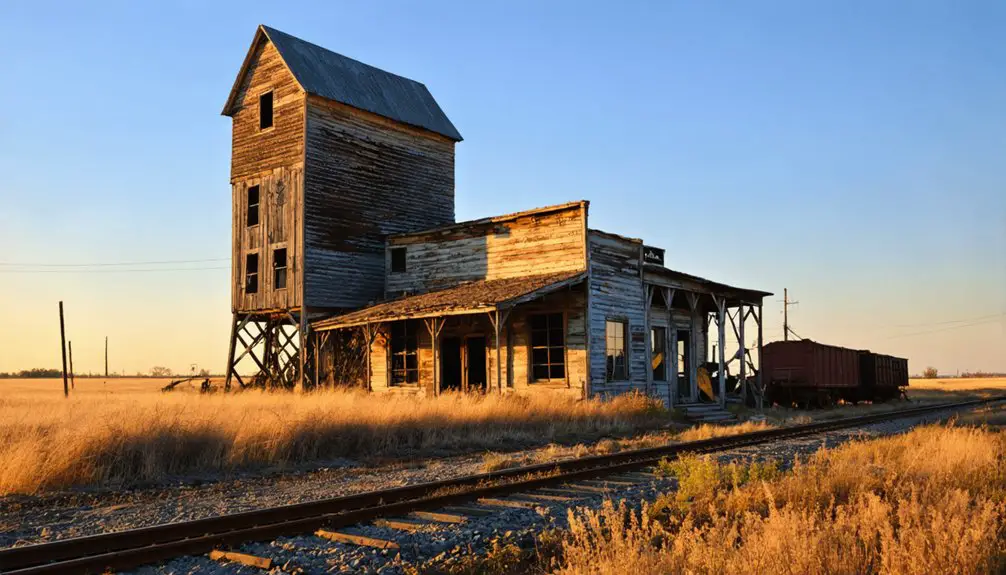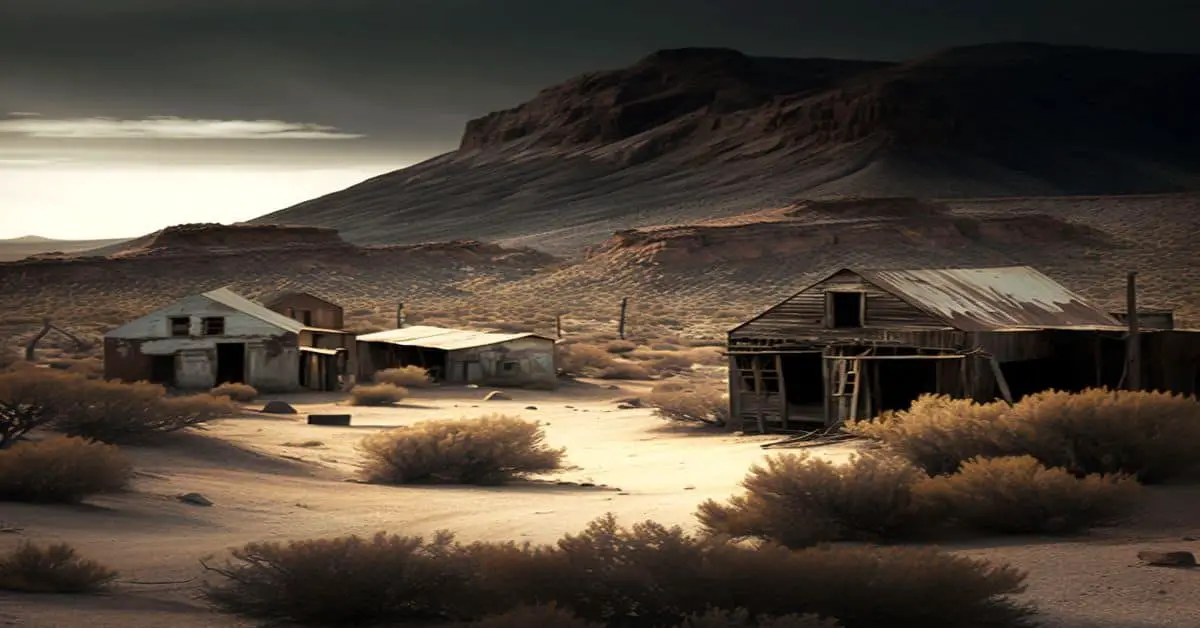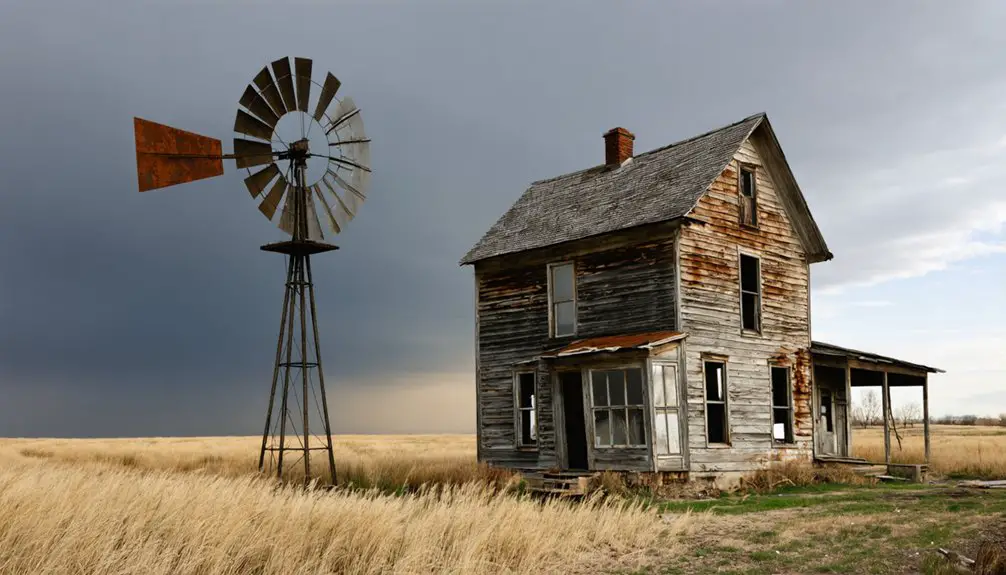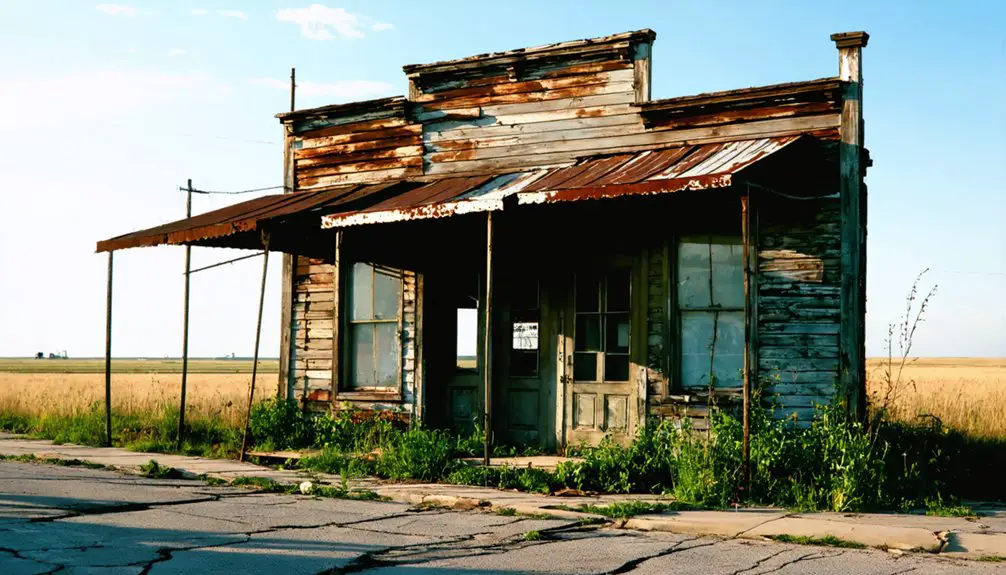You’ll find Lemoyne’s ruins 50 feet beneath Lake McConaughy’s waters in western Nebraska. This prairie town of 200 residents, established in the 1880s, thrived with a general store, bank, and railroad connection until the 1930s Kingsley Dam project forced its relocation. While residents moved to “New Lemoyne” on higher ground in 1941, the original townsite occasionally reveals itself during severe droughts, offering glimpses into Nebraska’s submerged past.
Key Takeaways
- Lemoyne was a thriving Nebraska town submerged under Lake McConaughy in 1941 due to the Kingsley Dam project.
- The original town sits approximately 50 feet underwater, with foundations occasionally visible during severe drought conditions.
- Residents were forced to relocate to New Lemoyne on higher ground, leaving behind their homes and established community.
- During the 2004 drought, remnants of the original town emerged, revealing building foundations and historic town boundaries.
- The underwater ghost town serves as a unique archaeological site and reminder of sacrifices made for Nebraska’s water management infrastructure.
The Birth of a Prairie Settlement
While westward expansion swept across Nebraska in the late 19th century, settlers established Lemoyne along the banks of the North Platte River.
You’d have found pioneers drawn by the Homestead Act‘s promise of 160 acres, provided they could improve the land over five years. Settlement challenges included harsh winters, grasshopper plagues, and the ever-present threat of flooding from the nearby river.
Through agricultural adaptation, settlers made the most of the fertile river valley soils, establishing farms and building sod houses suited to prairie conditions. Lemoyne Jacobs led the settlement efforts in the mid-1880s. The settlers’ daily lives were captured through Butcher’s photographs, documenting their homesteading experiences.
You’ll recognize their determination in how they created a bustling community, complete with churches, schools, and essential businesses.
The railway’s arrival enhanced Lemoyne’s connectivity, transforming it from a frontier outpost into a growing prairie town.
Life in Early Lemoyne
If you’d visited early Lemoyne, you’d have found yourself immersed in a bustling prairie life where homesteaders tended their riverside farms and grazed cattle on the surrounding sandhills.
The town’s focal points included essential community buildings like the post office, which served as both a mail hub and gathering place for the growing population. The town’s name required disambiguation pages due to multiple locations sharing the same title.
Local businesses emerged to support the agricultural community, with residents engaging in trade and bartering while maintaining largely self-sufficient households along Nebraska Highway 92. Located just minutes from Lake McConaughy, Lemoyne’s residents enjoyed easy access to what would become Nebraska’s largest reservoir.
Daily Pioneer Activities
As dawn broke over early Lemoyne, Nebraska, residents began their daily routines shaped by agricultural demands and seasonal rhythms.
You’d find farmers tending to livestock, repairing equipment, and working their fields while children helped with pioneer chores before heading to the local schoolhouse.
At home, you’d see women preserving food, managing wood stoves, and maintaining households through essential tasks like laundry and sewing.
Your daily life would’ve included trips to the stockyard, coordinating rail shipments, or driving horse-drawn carts to neighboring markets. After Lemoyne Jacobs’ success, the railroad brought increased trade and commerce to the bustling town.
You’d build community bonds through social visits, church gatherings, and stops at the general store. The town’s vitality continued until Lake McConaughy’s creation forced residents to relocate their homes and businesses.
When evening came, you’d join neighbors for storytelling or simple outdoor games, marking the end of another day guided by agricultural rhythms.
Community Buildings and Businesses
The bustling center of Lemoyne featured a collection of buildings that served both economic and social needs of its residents.
The Presbyterian church became a cornerstone of the community’s spiritual life. The Union Pacific Railroad brought vital transportation connections to surrounding communities. The town’s community services revolved around several key structures that created significant economic impact for the region’s approximately 200 inhabitants by the 1920s.
You’d find essential establishments including:
- A well-stocked general store providing daily provisions and supplies
- A bustling stockyard supporting local ranching and livestock trade
- A hotel welcoming travelers and fostering commerce
- A bank facilitating financial transactions for the growing community
The barbershop rounded out these crucial services, making Lemoyne a self-sufficient hub until Lake McConaughy’s creation in the 1930s forced residents to relocate their community to higher ground, taking their salvaged building materials with them.
The Kingsley Dam Project
Due to persistent drought cycles affecting Nebraska agriculture, C.W. McConaughy proposed a plan for supplemental irrigation in 1913. The project evolved from smaller reservoirs to a massive undertaking – the Kingsley Dam on the North Platte River near Ogallala.
The dam’s water-facing side features limestone rock layers transported from Wyoming quarries. A temporary settlement called Kingsley Ville was built to house the construction workers during the project.
Construction began in 1936 with $20 million in federal funding through Roosevelt’s New Deal.
You’ll find the dam impressive: standing 163 feet high, it’s an earthen structure with a 3.5-mile core trench and steel piling forming a watertight base. The project created Lake McConaughy, spanning 30,500 acres.
Four hydroelectric plants were integrated, including the Kingsley Hydro added in 1984. The irrigation impact transformed Nebraska’s agricultural capabilities, making it a leading producer of corn and grain while providing affordable power to farmers throughout the Platte Valley.
Community Response and Resistance
When federal authorities announced plans for a diversion dam near Keystone in 1935, Lemoyne’s residents immediately mounted fierce opposition to protect their community. Their community activism took various forms as they fought to preserve their way of life:
- Many families rejected the designated relocation site, choosing to move elsewhere.
- Residents rushed to document and preserve structures before demolition.
- Former resident Cora Baumann led historical preservation efforts through detailed documentation.
- Community members preserved their cultural identity through poems and oral histories.
Despite their determined resistance, state authorities proceeded with mandatory relocation orders.
You’ll find that while the physical structures fell to demolition crews, the spirit of resistance lived on through archived collections, commemorative events, and stories passed down through generations – a reflection of the community’s unwavering resolve against forced displacement.
The Great Relocation
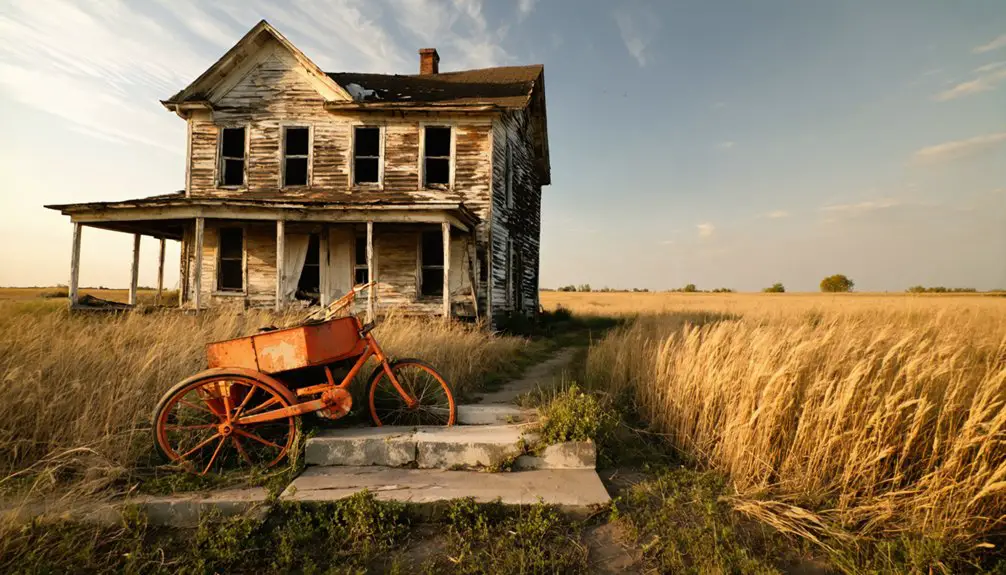
You’ll find that the Great Relocation of Lemoyne began around 1937, when residents received formal notice to move from their homes due to the impending flooding from Lake McConaughy’s creation.
Throughout the late 1930s and early 1940s, the town’s 200 residents faced difficult choices as buildings were dismantled and infrastructure was either relocated to “New Lemoyne” or abandoned entirely.
While some families moved to the new townsite at higher elevation, many chose to disperse to other communities like Brule, leading to a dramatic population decrease that left modern-day Lemoyne with just 44 residents by 2020.
Community Forced to Move
As the Kingsley Dam project took shape in the mid-1930s, residents of Lemoyne faced an inevitable displacement from their homes. Despite initial resistance, the community demonstrated remarkable resilience as they dismantled their lives piece by piece, relocating to higher ground north of the original site.
The emotional upheaval of leaving their historic town behind manifested in several ways:
- Families tearfully bid farewell to their longtime homes and neighbors.
- Some residents chose to leave the area entirely, settling elsewhere in Nebraska.
- The town’s essential services, including the bank, moved to neighboring communities.
- Local businesses had to reestablish themselves in New Lemoyne or nearby towns.
Residents Choose New Paths
During the tumultuous 1930s changeover, Lemoyne’s residents faced difficult choices about their future paths. Most opted to rebuild their lives by moving to higher ground, establishing what you’d know as “New Lemoyne” north of the lake.
Others, driven by different relocation motivations, chose to scatter to nearby communities like Brule and Ogallala.
G.D. Adams relocated the Lemoyne State Bank to Brule, while other business owners either dismantled their operations or started fresh in the new location.
Economic opportunities played a significant role in these decisions, with some families adapting their agricultural practices to new land.
You’ll find that social ties and individual circumstances shaped each family’s choice, leading to a gradual dispersal of the once-tight-knit community.
Underwater Legacy
When Lake McConaughy’s waters filled in 1941, they submerged the original town of Lemoyne beneath approximately 50 feet of water.
Today, this underwater ghost town represents a unique piece of Nebraska’s underwater archaeology, occasionally revealing its secrets during drought conditions.
Beneath Lake McConaughy’s waters lies Lemoyne, a sunken ghost town that emerges like a secret whisper during Nebraska’s driest days.
- Foundations and small artifacts become visible when water levels drop considerably
- In 2004, a major drought exposed portions of the town ruins
- Historical preservation efforts focus on photo documentation rather than artifact removal
- Local historian Cora Baumann’s detailed records preserve Lemoyne’s pre-submersion history
You’ll find Lemoyne’s legacy lives on beneath the waves of what’s now a popular recreation area.
While summer visitors enjoy the lake’s activities, they’re often unaware they’re floating above a piece of Nebraska history, where wisps of memories still linger in the depths below.
New Lemoyne Takes Root
You’ll find New Lemoyne‘s determined residents rebuilding their community on higher ground north of Lake McConaughy in 1941, choosing to stay together despite the emotional upheaval of leaving their submerged hometown.
While some families scattered to different locations, those who remained worked to establish new foundations along Nebraska Highway 92, maintaining their postal service and community identity.
Through their collective effort, you can see how the relocated townsite took shape at 3,347 feet elevation, though it never quite achieved the growth trajectory of its underwater predecessor.
Community Rebuilds Up North
After the construction of Kingsley Dam in the 1930s submerged the original town, Lemoyne’s resilient residents chose to rebuild their community on higher ground nearby, creating what became known as New Lemoyne.
The town’s resilience strategies and strong community bonds led to a remarkable transformation.
You’ll find New Lemoyne situated uniquely with water on three sides, offering:
- Prime lakeside access for fishing and boating enthusiasts
- Strategic positioning that maintains connection to Lake McConaughy
- Modern recreational infrastructure including boat ramps and camping facilities
- Thriving tourism opportunities that replaced traditional agricultural focus
The rebuilt community exemplifies the independent spirit of its residents, who turned potential displacement into an opportunity for growth.
New Lemoyne’s strategic location and focus on outdoor recreation have helped preserve the town’s legacy while forging a new identity.
Displaced Families Stay Together
The forced displacement of Lemoyne’s original residents in 1935 sparked a remarkable display of community solidarity. Despite the heartbreak of leaving their homes behind, many families chose to stick together, establishing what became known simply as Lemoyne on higher ground north of the reservoir.
You’ll find that these displaced residents maintained their community bonds by salvaging materials from their original structures to build temporary dwellings. They deliberately kept the name Lemoyne, refusing to adopt the “New” prefix, as a symbol of their shared histories.
Local historian Cora Baumann helped preserve their stories, while families worked tirelessly to maintain their connections. Though some residents scattered to different locations, those who stayed created a tight-knit community, proving that their spirit couldn’t be submerged like their former homes.
New Foundations Take Shape
When state officials finalized plans for Lake McConaughy in the mid-1930s, residents of original Lemoyne began establishing their new community on higher ground north of the reservoir site.
Their community resilience showed through immediate action and resourcefulness:
- You’ll find they salvaged materials from demolished buildings to construct temporary homes
- They quickly relocated essential infrastructure before flooding began
- They maintained their identity by keeping the name Lemoyne
- They preserved historical connections through careful documentation by residents like Cora Baumann
Preserving Town Memories
Despite being submerged beneath Lake McConaughy’s waters, Lemoyne’s legacy lives on through dedicated preservation efforts spanning several decades.
You’ll find Cora Baumann’s extensive 50-year documentation at the Nebraska State Historical Society Archives, where she’s preserved the town’s history and its families’ displacement stories. Through community nostalgia and oral histories, descendants continue sharing personal narratives that capture both the spirit of the town and the trauma of relocation.
During droughts, you can witness the town’s physical remnants when the lake level drops, exposing original foundations and marking historic boundaries.
Beneath Lake McConaughy’s waters, Lemoyne’s ghostly foundations emerge during dry seasons, revealing traces of the submerged town’s past.
Julius Hoffman’s poems and residents’ writings enrich the cultural memory, while anniversary events and heritage markers near the lake guarantee that Lemoyne’s sacrifice won’t be forgotten.
The relocated community’s name, “New Lemoyne,” stands as a living symbol of the original town.
Drought Revelations
During severe drought conditions in 2004, Lake McConaughy’s water volume plummeted to 340,000 acre-feet, dramatically exposing Lemoyne’s submerged foundations to daylight for the first time since its flooding in the 1940s.
The drought impact revealed the skeletal remains of this once-thriving community, offering a rare glimpse into Nebraska’s past.
When you visit during these revealing drought periods, you’ll discover:
- Stone foundations marking where buildings once stood
- Historical artifacts emerging from the receding waters
- Evidence of the original town layout and infrastructure
- Insights into the community’s forced relocation
The historical significance of these drought revelations extends beyond mere curiosity – they’ve sparked renewed interest in documenting Lemoyne’s story and understanding the profound effects of large-scale water management projects on local communities.
Lessons From a Submerged Past
The forced relocation of Lemoyne in the 1940s offers profound lessons about the human cost of large-scale infrastructure projects.
You’ll find that when community heritage collides with development, the consequences ripple through generations. The town’s submersion beneath Lake McConaughy serves as a stark reminder of how environmental justice often took a back seat to progress in the mid-20th century.
Through Cora Baumann’s documentation efforts, you can trace how displaced families struggled to maintain their identity after relocation.
Today, when drought exposes Lemoyne’s foundations, you’re witnessing more than just concrete ruins – you’re seeing the physical evidence of choices that prioritized regional infrastructure over local communities.
These remnants challenge you to reflect on how modern development can better balance progress with preservation.
Frequently Asked Questions
What Was the Average Population of Lemoyne Before the Relocation?
You’d laugh at today’s ghost towns, but this place’s historical significance peaked around 200 residents in the 1920s before the crushing population decline. That’s your average – freedom wasn’t free when dams came calling.
Are There Any Annual Events or Festivals Celebrating Old Lemoyne’s History?
You won’t find specific annual events celebrating old Lemoyne’s past. While there are historical reenactments and community gatherings in Keith County, they focus on broader regional heritage rather than Lemoyne’s story.
Did Any Original Buildings Survive the Move to New Lemoyne?
Like scattered puzzle pieces, you won’t find any complete historic buildings that survived. During the 1937 building relocation, structures weren’t preserved intact – they were dismantled and their materials reused elsewhere.
What Native American Tribes Originally Inhabited the Lemoyne Area?
You’ll find the Pawnee tribes were the earliest long-term inhabitants, settling along the Platte River around 500 years ago, while Lakota influence grew as they migrated westward in later centuries.
How Deep Underwater Is the Original Lemoyne Townsite Today?
You’ll find the original townsite’s underwater depth varies with lake levels – while exact measurements aren’t consistently documented, during non-drought periods it lies completely submerged beneath Lake McConaughy’s waters.
References
- https://ominous.app/blog/2022-11-12/top-3-abandoned-places-in-nebraska
- https://ruralresurrection.com/ghost-towns-lemoyne-nebraska/
- https://history.nebraska.gov/flashback-friday-encore-town-of-lemoyne-sacrificed-for-lake-mcconaughy-1941/
- https://ruralresurrection.com/category/ghost-towns/
- http://mrsteapotstinytots.com/index-2028.html
- https://teachinghistory.org/history-content/website-reviews/14665
- https://historymatters.gmu.edu/d/5646/
- https://www.nebraskastudies.org/1850-1874/
- https://nebraskacityne.gov/history-of-nebraska-city/
- https://www.landsearch.com/properties/1-old-hwy-61-lemoyne-ne-69146/4319036
